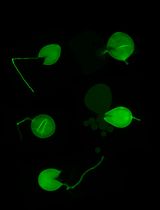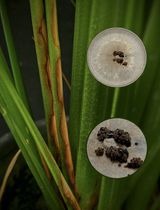- EN - English
- CN - 中文
Antifungal and Zearalenone Inhibitory Activity of Ocimum sanctum L. Essential Oil on Fusarium graminearum Determined by UHPLC and RT-qPCR
采用UHPLC和RT-qPCR技术在禾谷镰刀菌上测定罗勒属精油的抗真菌和玉米烯酮抑制活性
发布: 2016年08月05日第6卷第15期 DOI: 10.21769/BioProtoc.1893 浏览次数: 10532
评审: Arsalan DaudiArsheed Hussain SheikhPriyanka Das
Abstract
Fusarium graminearum has been given special attention in the context of agricultural commodities due to its ability to grow in diverse climatic conditions, and to produce different mycotoxins including zearalenone (ZEA) and type-B trichothecenes, which cause ill health effects on humans, animals and plants. The application of synthetic antifungal agents for the control of F. graminearum result in negative health impacts in livestock and humans and the upsurge of resistant organisms as well. Therefore, there is a need to propose proper food grain management practices, including the application of herbal antifungal and mycotoxin controlling agents, to reduce the growth of toxigenic F. graminearum as well as the production of ZEA in agricultural commodities. Ocimum sanctum also known as Holy Basil or Tulsi is widely used as a medicinal plant in Ayurveda. The current protocol demonstrates to quantify the antifungal activity of O. sanctum L. essential oil (OSEO) as reflected by the decreased F. graminearum growth and ZEA production. Antifungal activities of OSEO are carried out by micro well dilution method and further validated quantitatively by scanning electron microscopic methods. Effects of OSEO on ZEA production is analysed by Quantitative reverse transcription PCR (RT-qPCR) and Ultra high performance liquid chromatography (UHPLC) methods from a broth culture of F. graminearum. Anti-mycotoxic efficacy of OSEO is assessed directly on F. graminearum inoculated maize grains. The protocol efficiently assessed the activity of OSEO as an herbal antagonistic agent against fungal infestation and ZEA production by F. graminearum. The protocol can be used to test a wide variety of herbal compounds for antifungal activity against F. graminearum or with modifications on other mycotoxigenic fungi, an important intervention in food safety and processing industries where the fungal infestation is a major concern.
Keywords: Zearalenone (玉米赤霉烯酮)Materials and Reagents
- 0.22 µm Millex-GP syringe filter unit (Sigma-Aldrich, catalog number: Z359904 )
- 96-well microtiter plates (Eppendorf, catalog number: 0030602200 )
- Column C18, 5 µm, 250 x 4.6 mm (Phenomenex, catalog number: 00G-4041-E0 )
- Carbon Conductive Tape (Ted Pella, Inc., catalog number: 16084-7 )
- Glass slides (HiMedia, catalog number: CG081 )
- Whatman No.1 paper (Sigma-Aldrich, catalog number: Z274852 )
- Zearalenone producing F. graminearum [The Microbial Type Culture Collection and Gene Bank, (MTCC), catalog number: 1893 ]
- Maize grains (Local agricultural market, Mysore, India)
- Zearalenone standard (Sigma-Aldrich, catalog number: Z2125 )
- Dimethyl sulfoxide (Merck Millipore, catalog number: 317275 )
- Distilled water
- Sodium chloride (NaCl) (Merck Millipore, catalog number: 1064040500 )
- Potassium chloride (KCl) (Merck Millipore, catalog number: 1049360250 )
- Sodium phosphate dibasic (Na2HPO4) (Merck Millipore, catalog number: 567550-1KG )
- Potassium phosphate monobasic (KH2PO4) (Merck Millipore, catalog number: 1048730250 )
- 0.1 M sodium cacodylate buffer, pH 6.5 (Sigma-Aldrich, catalog number: 70114 )
- 25% glutaraldehyde (Merck Millipore, catalog number: 354400 )
- Acetonitrile (Merck Millipore, catalog number: 100030 )
- Ethanol (Merck Millipore, catalog number: 100983 )
- Gold foil (Sigma-Aldrich, catalog number: 265829 )
- Immunoaffinity column of ZEA (Vicam, catalog number: G1026 )
- iScript One-Step RT-PCR Kit with SYBR Green (Bio-Rad Laboratories, catalog number: 1708892 )
- Liquid nitrogen (Local suppliers, Mysore, India)
- Nuclease-free water (Qiagen, catalog number: 129114 )
- Nystatin (Sigma-Aldrich, catalog number: N6261 )
- Ocimum sanctum L. essential oil (OSEO) (prepared as describe in Procedure step 2)
- Peptone (HiMedia, catalog number: RM001-500G )
- Porcelain mortar (Sigma-Aldrich, catalog number: Z529508 )
- RNA easy plant Mini kit (Qiagen, catalog number: 74903 )
- Sabouraud dextrose agar (HiMedia, catalog number: M063-500G )
- Sabouraud dextrose broth (HiMedia, catalog number: M033-500G )
- Synthesized primer sequences (Sigma-Aldrich, Bangalore, India)
- Tween 80 (Merck Millipore, catalog number: 822187 )
- Lactophenol-cotton blue (HiMedia, catalog number: S016-500ML )
- Phosphate-buffered saline (pH 7.4) (see Recipes)
- Lactophenol-cotton blue staining solution (see Recipes)
Equipment
- Milli-Q integral water purification system (Merck Millipore, catalog number: ZRXQ005WW )
- Aluminum stubs (Ted Pella, Inc., catalog number: 16111N )
- Autoclave (Medica Instrument Manufacturing Company, model: 7431PAD )
- Microcentrifuge (Sigma-Aldrich, Eppendorf, model: 5415 R )
- Centrifuge (Eppendorf, model: 5430 R )
- Hemocytometer (Sigma-Aldrich, catalog number: Z359629 )
- Hot-air oven (Memmert, model: UFP800DW )
- Incubator (Bio-age, model: BSR-R2 )
- Real-Time PCR system (Roche Diagnostics, Light cycler®, model: 480 )
- 0.5-10 µl micropipette (Eppendorf Research plus, catalog number: 3120000020 )
- 20-200 µl micropipette (Eppendorf Research plus, catalog number: 3120000054 )
- 100-1,000 µl micropipette (Eppendorf Research plus, catalog number: 3120000062 )
- Microscope (Leica Microsystems, model: Leica DM 1000 LED )
- 250 ml Erlenmeyer flasks (Duran Group, catalog number: 21 216 36 )
- 500 ml Erlenmeyer flasks (Duran Group, catalog number: 21 216 44 )
- NanoDrop 8000 spectrophotometer (Thermo Fisher Scientific, catalog number: ND-8000-GL )
- Nexera UHPLC system (Shimadzu Corporation, model: Nexera X2 )
- Scanning electron microscope (FEI, model: Quanta 200 )
Note: This product has been discontinued by the manufacturer [Replaceable items (FEI, model: Quanta 250/450/650 )]. - Shaker Incubator (Bio-age, model: BSR-R1 )
- Sputter coater (Quorum Technologies, model: SC7620 )
- Water bath (NUVE, model: NB 5 )
- Weighing balance (Denver instruments, model: TB-215D )
Software
- GeneRunner software version 5.0.47 Beta
Procedure
文章信息
版权信息
© 2016 The Authors; exclusive licensee Bio-protocol LLC.
如何引用
Kalagatur, N. K., Dhamodaran, N., Siddaiah, C., Mudili, V. and Sreepathi, M. H. (2016). Antifungal and Zearalenone Inhibitory Activity of Ocimum sanctum L. Essential Oil on Fusarium graminearum Determined by UHPLC and RT-qPCR. Bio-protocol 6(15): e1893. DOI: 10.21769/BioProtoc.1893.
分类
微生物学 > 抗微生物试验 > 抗真菌试验
微生物学 > 微生物-宿主相互作用 > 真菌
植物科学 > 植物生物化学 > 脂质
您对这篇实验方法有问题吗?
在此处发布您的问题,我们将邀请本文作者来回答。同时,我们会将您的问题发布到Bio-protocol Exchange,以便寻求社区成员的帮助。
Share
Bluesky
X
Copy link
















